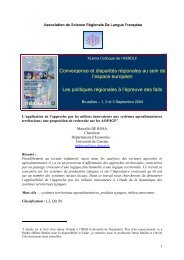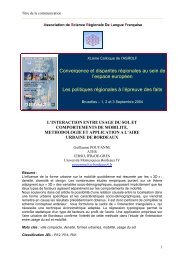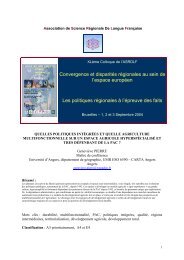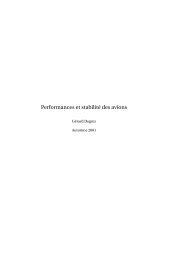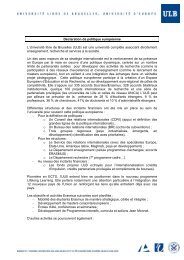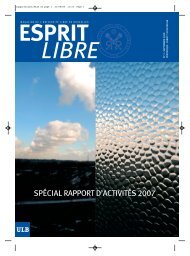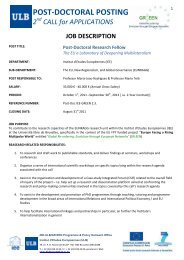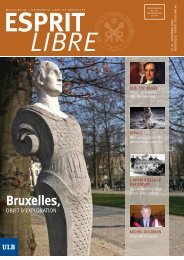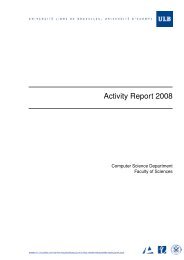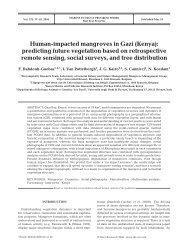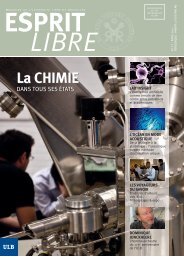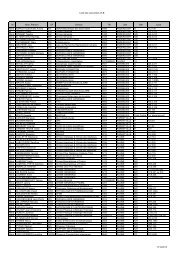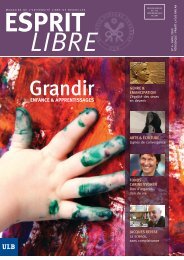Create successful ePaper yourself
Turn your PDF publications into a flip-book with our unique Google optimized e-Paper software.
<strong>ENGLISH</strong>: <strong>Law</strong> <strong>Study</strong> <strong>Case</strong><br />
Teacher: David Albert Best<br />
1
Table of contents:<br />
A. Introduction........ .................................................................................................3<br />
B. Facts of the case....................................................................................................3<br />
C. Actors of the case……..........................................................................................4<br />
D. National proceeding.............................................................................................5<br />
D.1. The court of first instance......................................................................................................5<br />
D.2. The court of appeal................................................................................................................5<br />
D.3. Appeal to the Supreme Court................................................................................................6<br />
E. Legal issues and proceeding to the European Court of Human Rights……...6<br />
E.1. Violation of third article .......................................................................................................7<br />
E.2. Violation of Article 3 in conjunction with Article 14............................................................8<br />
E.3. Violation of Article 3 and 13 in conjunction with Article 6§1 .............................................8<br />
E.4. Procedure and composition of the Court........................................................................…...8<br />
F. Similar <strong>Case</strong>s..........................................................................................................9<br />
F.1. Pantea v. Romania...................................................................................................................9<br />
F.2. Natchova v. Bulgaria...............................................................................................................9<br />
G. Final decision......................................................................................................10<br />
H. Conclusion...........................................................................................................10<br />
I. Bibliography.........................................................................................................11<br />
2
A. Introduction<br />
When we are watching TV, we discover that many countries do not respect Human Rights. We al-<br />
ways think that this phenomenon happened far away from us. But unfortunately we must not go too<br />
far to find these violations. Indeed, we are living in a country in which this reality exists. How can<br />
we explain that a constitutional and democratic state acts like this and close their eyes on? We fair<br />
today that there is not guarantee that our most fundamental rights are respected. “Turan Cakir vs.<br />
Belgium” is a good illustration of this paradox. The case goes back to 16 years and the allegations<br />
are serious. In fact, Belgium is condemned for inhuman treatment and racist behavior. That is worth<br />
first of all turning on is attention to the facts of the case (B). Then the different actors (applicants,<br />
lawyers…) (C). After this, we can talk about the national procedure which shows a real passive<br />
behavior from the Belgian Courts (D). The analysis of point E will lead us to European Court of<br />
Human Rights (ECHR) (E). Unfortunately we'll see that there are many similar cases in the world;<br />
we have chosen more specifically 2 cases: Romania and Bulgaria (F).<br />
B. The facts of the case<br />
The applicant, Turan Cakir, is a Belgian citizen who was born in 1967. He lives in Schaerbeek<br />
(Belgium) and is of Turkish origin. The case concerned the applicant’s allegations that he was sub-<br />
jected to ill-treatment on the basis of racist prejudice during his arrest and while held in police cus-<br />
tody. On 17 March 1996 a quarrel erupted during the arrest of the applicant’s brother at the family<br />
home in Schaerbeek. The facts are in dispute between the parties. The applicant alleged that he had<br />
been pinned to the ground, handcuffed and struck by three police officers.<br />
He had then been dragged along the ground to a vehicle, and had been subjected to racist threats<br />
and insults during the journey to the police station, where police officers had struck him again and<br />
hit him on the head with a seat and a telephone directory. On the other hand, according to the Bel-<br />
3
gian Government, during the arrest the police officers had been required to use a pepper spray and<br />
to “kick the applicant’s feet out from under him”, thus knocking him to the ground, in an attempt to<br />
control him.<br />
The applicant appeared to be under the influence of drugs and fought violently, so that it was im-<br />
possible to place handcuffs on him. The police officers had been surrounded by people who began<br />
to strike and insult them. Mr. Cakir himself had been kicked by those individuals. A medical certifi-<br />
cate drawn up on the following day recorded a substantial bruise with complete ptosis of the appli-<br />
cant’s right eye, bruising on both wrists and the left hypochondrium, a stitched wound on the left<br />
eye socket and the scalp, a fracture of the root of the nose, pain in the right hypochondrium with<br />
headaches and pain in the left mandibular region. The applicant was hospitalised for ten days and he<br />
was not able to work anymore. One of the police officers was declared, among other things, unfit to<br />
work for one day. On 22 March 1996 the applicant lodged a criminal complaint together with an<br />
application to join the proceedings as a civil party. At the end of those proceedings the Belgian<br />
courts issued an order that there was no case to answer on 17 October 2000. In addition, on 26 April<br />
2006 the Indictments Division issued a judgment ruling that any prosecution was time-barred.<br />
C. Actors of the case.<br />
• There are 2 different parts in the process:<br />
1. The claimants: Turan Cakir who was represented and assisted by S. Benkhelifa, T.<br />
Mitevoy, J. Callewaert, and V. Henkinbrant<br />
2. The defenders: The Belgian Government who was represented by the Chief<br />
executive officer at the federal Public service of Justice: M. Daniel Flore.<br />
• Definition of legal words 1 :<br />
� <strong>Law</strong>yers: Is a general word for someone who as professional training in legal work<br />
1 http://legal-dictionary.thefreedictionary.com<br />
4
or who is an expert in law. <strong>Law</strong>yers in our case: S. Benkhelifa, T. Mitevoy, J. Callewaert, V.<br />
Henkinbrant and M. Daniel Flore.<br />
� Clerk or Registrar: A law clerk is either a law student employed by a licensed<br />
attorney to do mundane legal tasks and learn the law in the process, or a licensed lawyer<br />
working for a judge to aid in the writing and research of the cases before the judge. The<br />
clerk of our case was Sally Dollé<br />
� Magistrate: s a generic term for any judge of a court, or anyone officially<br />
performing a judge's functions. In a few states, an officer of the court at the lowest level<br />
which hears small claims lawsuits, serves as a judge for charges of minor crimes, and/or<br />
conducts preliminary hearings in criminal cases to determine if there is enough evidence<br />
presented by the prosecution to hold the accused for trial. The magistrates in our case were :<br />
Ireneu Cabral Barreto (Portugal), President, Françoise Tulkens (Belgium), Vladimiro<br />
Zagrebelsky (Italy),Danutė Jočienė (Lithuania), Dragoljub Popović (Serbia), András Sajó<br />
(Hungary), Nona Tsotsoria (Georgia)<br />
1. The court of first instance<br />
D. National proceeding<br />
At first, Mr CAKIR Turan and his advisers introduce an action to the Court of First Instance,<br />
against the three police officers. Mr CAKIR institutes a civil action. The judge of first instance<br />
dismissed the case because there are no sufficient elements to send the policemen to the Court.<br />
Indeed, the hearing had been adjourned to many times. It was necessary to respect the statute of<br />
limitations of five years but it has not been respected. Actually no date had been set for the hearing.<br />
2. The court of appeals<br />
Therefore Mr CAKIR does not proceed no further and he decides to lodge an appeal against the<br />
judgment through the Court of Appeal. The Indictment Division finds that appeal is admissible.<br />
These Court notices that the prescription of public action has been normally interrupted by the<br />
5
appeal is act of civil applicant. Then the Court of appeal draws attention to the fact that five years<br />
have elapsed since this act. That is why the Court considers that the public action is prescribed.<br />
3. Appeal to the Court of Cassation<br />
As he does not win his case, the plaintiff takes his case to the final. Unfortunately for him, the Court<br />
of Cassation judges only about the form and not the content. But there is an ultimate possibility.<br />
But the hardest part is still to be done: the claimant brings an action before the European Court of<br />
Human Rights.<br />
E. Legal issues and proceeding to the European Court of Human Rights<br />
First we can see violations of many articles of European convention on human rights : article 3,<br />
article 3 in conjunction with article 14 and finally a violation of article 3 in conjunction with article<br />
13 and 6§1. So a total of 4 articles of ECHR were not respected by Belgium.<br />
Regarding the legal issues, we note Article 3 of ECHR presents the prohibition of torture: « No one<br />
shall be subjected to torture or to inhuman or degrading treatment or punishment ».<br />
Then Article 14 concerns the prohibition of discrimination : « The enjoyment of the rights and free-<br />
doms set forth in this Convention shall be secured without discrimination on any ground such as<br />
sex, race, color, language, religion, political or other opinion, national or social origin, association<br />
with a national minority, property, birth or other status » and the article 13 refers to the Right to an<br />
effective remedy : « Everyone whose rights and freedoms as set forth in this Convention are violat-<br />
ed shall have an effective remedy before a national authority notwithstanding that the violation has<br />
been committed by persons acting in an official capacity ».<br />
Finally the article 6§1 refers to the Right to a fair trial : « 1. In the determination of his civil rights<br />
and obligations or of any criminal charge against him, everyone is entitled to a fair and public<br />
hearing within a reasonable time by an independent and impartial tribunal established by law.<br />
Judgment shall be pronounced publicly but the press and public may be excluded from all or part of<br />
the trial in the interests of morals, public order or national security in a democratic society, where<br />
the interests of juveniles or the protection of the private life of the parties so require, or to the ex-<br />
6
tent strictly necessary in the opinion of the court in special circumstances where publicity would<br />
prejudice the interests of justice ».<br />
Relying on Article 3, Article 6 § 1 and Article 13, the applicant reports that he was ill-treated during<br />
his arrest and complains that Belgian authorities didn't do an effective investigation. He also de-<br />
clares that he suffered racial insults, discriminatory and many violent treatments during the arrest.<br />
For each violation of articles let's see what the different actors of this trial have been pled.<br />
E.1. Violation of third article:<br />
First there is a controversy over the admissibility of this appeal. In fact, the Belgian government<br />
says Mister Cakir has not exhausted all the possible domestic remedies. For his defense, Mister<br />
Cakir explains due to the lack of action of Belgian authorities he has taken many initiatives to set a<br />
hearing in front the Indictment Division. Then this one said that prosecution was time-barred.<br />
According to the various arguments, the Court does not agree with the argument of the Belgian state<br />
concerning the inadmissibility with regard to non-exhaustion of remedies.<br />
The Court held that there is no useful remedy to the national Courts, so there is an available reason<br />
to go immediately to the ECHR.<br />
After procedure's problem, we can notice an issue about the violation of this third article. First let's<br />
see the government's opinion. This one exposes for his defense that the 3 police officers might have<br />
hit the applicant, but it was not free. Furthermore the applicant was drunk so when the police offic-<br />
ers put him on the floor, Mister Cakir had very bad reflexes and later he stayed not longer enough in<br />
the police station for receiving these injuries. Finally there are to many contradictions in the appli-<br />
cant's statements.<br />
However Mr Cakir asserts that was not right to put him on the floor in the beginning of this search.<br />
Moreover he presented a lot of serious injuries at the hospital and according to report, the police<br />
officers received a lot of blows from Mr. Cakir but this assertion is not true when we see the medi-<br />
co-legal report. In regards with these two reports, we notice the versions of events put forward by<br />
7
the parties, differed substantially, there were uncontested elements that allowing the Court to de-<br />
termine whether the force used had been proportionate. First, the 3 police officers admmitted having<br />
used force and striking Mr. Cakir, and said that the crowd wad involved. Therefore a lot of blows<br />
have been given from this crowd who had taken mister Cakir's side. However the Court are no so<br />
convinced about this argument. In view of Cakir's hospitalization, the Court states this use of vio-<br />
lence in this case was not proportionate.<br />
E.2. Violation of Article 3 in conjunction with Article 14:<br />
The government claims the police officers do not agree with statements is applicant, and strongly<br />
contest those. Furthermore the applicant could not prove these discriminations.<br />
The applicant responds it is too difficult to get some evidence, because the insults happened in the<br />
police's car.<br />
The Court considers that the Crown Prosecutor does not give his opinion in his submissions inviting<br />
the judge's chambers about insults from the police officers. So the Court considers that the Belgian<br />
authorities have no taken their job seriously, and they did not make an effective investigation, to<br />
find out if there have been racial insults during the search.<br />
E.3. Violation of Article 3 and 13 in conjunction with Article 6§1:<br />
The Court considers that it was unnecessary to examine separately the complaints under Article 13<br />
and Article 6§1.<br />
E.4. Procedure and composition of the Court:<br />
Judgment was given by a Chamber of seven judges, composed as follows: Ireneu Cabral Barreto<br />
(Portugal), President, Françoise Tulkens (Belgium), Vladimiro Zagrebelsky (Italy), Danutė Jočienė<br />
(Lithuania), Dragoljub Popović (Serbia), András Sajó (Hungary), Nona Tsotsoria (Georgia), judg-<br />
es, and also Sally Dollé, Section Registrar.<br />
8
F.1. Pantea v. Romania 2<br />
F. Similar <strong>Case</strong>s<br />
As every trial to the ECHR, there are many references to other cases.<br />
We are going to explore some of them.<br />
In the area of violation of Article 3, the Court mentions the case of Pantea v. Romania. The appli-<br />
cant complained about the threatment he received during his stay in jail and furthermore he also<br />
complained the national authorities had not conducted an effective inquiry into that treatment. The<br />
Court held unanimously that there was a violation of Article 3 of the Convention. The link between<br />
our case and this one is bad treatments that the applicants received from the police officers and the<br />
prison officers.<br />
F.2. Natchova v. Bulgaria<br />
In the area of violation of Article 3 in conjunction with Article 14, the Court refers to Natchova v.<br />
Bulgaria case.<br />
Issues: The applicants report that members of their family have been killed in violation of Article 2<br />
of the Convention, because the national authorities did not take a national law which prohibits the<br />
use of violence. Moreover they complain that the national authorities didn't do an effective investi-<br />
gation into the deaths ( violation of Article 2 and 13) and finally they also complain about hostile<br />
behavior that led to this death and about the fact that the police did not conduct an effective inves-<br />
tigation(violation of Article 2 in conjunction with Article 14).<br />
The Court decided that « the authorities had failed to investigate possible racist motives behind the<br />
events that had led to the deaths of Mr Angelov and Mr Petkov» 3 .<br />
We notice a link between our case and Natchova v. Bulgaria case because the national authorities<br />
did not take enough measures to conduct an effective investigation and the Court held violation of<br />
these articles.<br />
2 European Court of Human Rights, Pantea v. Romania, 3 juni 2003, Request n. 33343/96.<br />
3 European Court of Human Rights, Natchova and others v. Bulgaria, 6 juli 2005, Requests n.43577/98 et 43579/98.<br />
9
G. Final decision<br />
The Court has considered unanimously that there had been a violation of Article 3 of the ECHR on<br />
account of the ill-treatment inflicted on the applicant by the police; a violation of Article 3 of the<br />
Convention on account of the ineffective investigation ; and a violation of Article 3 in conjunction<br />
with Article 14 (prohibition of discrimination), in that the national authorities had not carried out<br />
all the necessary provisions to investigate whether the police officers is conduct had been discrimi-<br />
natory. Under Article 41 (just satisfaction), the Court awarded the applicant 15,000 Euros in respect<br />
of non-pecuniary damage and EUR 6,681.10 for costs and expenses.<br />
H. Conclusion<br />
We can say that this is an exceptional case because it involves police officers and because the fail-<br />
ures are incredible.<br />
Indeed, the ECHR found obviously that Belgium had not sufficiently investigated effectively Mr.<br />
Cakir also reported racist discrimination. This is something for the future which is interesting in that<br />
if someone invokes a discriminatory motive or racist aggression, the Court held that a duty to inves-<br />
tigate, take reasonable steps to determine if a racist attitude is the cause of aggression.<br />
10
� Books<br />
I. Bibliography<br />
§� CHRISTOFFERSEN Jonas, Fair Balance : Proportionality, Subsidiarity and Primarity in the<br />
Convention on Human Rights, ( Matinus Nijhoff Publishers, Netherlands, 2009).<br />
§� CLEMENTS Luke, European Human Rights : Taking a case Under The Convention,( Sweet<br />
and Maxwell, London, 1994).<br />
§� COUNCIL OF EUROPE, Rules of the Court, (Strasbourg, 1977).<br />
§� COUSINS Mel, The European Convention on Human Rights and Social Security<br />
<strong>Law</strong>,( Intersentia, Antwerp – Oxford – Portland, 2008).<br />
§� DELMAS-MARTY Mireille, The European Convention for the Protection of Humna<br />
Rights,( Kluwer Academic Publishers, 1992).<br />
§� EDEL Frédéric, The prohibition of discrimination under The European Convention on<br />
Human Rights ( Human right files, n°22, 2010)<br />
§� GUILD Elspeth, LESIEUR Guillaume, The European Court of Justice on the European<br />
Convention on Human Rights,( Kluwer <strong>Law</strong> International, London, 1998).<br />
§� KROIS-LINDER Amy, FIRTH Matt, Introduction to International Legal English<br />
(Cambridge: Cambridge University Press, 2008).<br />
§� PALERMO Francesco, SABANADZE Nathalie, National Minorities in inter-State<br />
Relations ( Human Rights and humanitarian law E-Books online, 2011)<br />
§� WAITER Patricia, Intercultural dialogue in the framework of European Human rights<br />
Protection ( White paper series-volume 1, 2010)<br />
§� WILDHABER Luzius, Human Rights, Democracy and the Rule of <strong>Law</strong>,( Dike, Zürich,<br />
2007).<br />
� Website<br />
§� http://legal-dictionary.thefreedictionary.com<br />
� Jurisprudence<br />
§� European Convention on Human Rights, signed the 4th november 1950 and came into force<br />
the 3th september 1953.<br />
§� European Court of Human Rights, Natchova and others v. Bulgaria, 6 juli 2005, Requests<br />
n°43577/98 et 43579/98.<br />
§� European Court of Human Rights, Pantea v. Romania, 3 juni 2003, Request n° 33343/96.<br />
11




